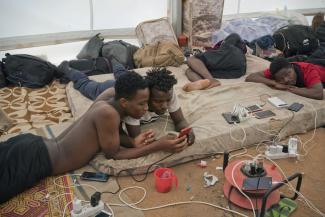EU policy
“The flow has not stopped”

You were born in Agadez and have been observing the situation there for many years. The city has become known internationally as a transit hub for refugees heading for North Africa and Europe. How many refugees are in the city, and where do they come from?
It is impossible to put a precise number on the size of the refugee and migrant population in Agadez. More than 2,500 from Sudan alone are estimated to be waiting for recognition as refugees. They have a tough time here because they are accused of being former rebels, either from Darfur or the war in Libya. In either case, they are stigmatised. The Sudanese are housed at 15 kilometres outside the city. They do not get the health care or psychosocial care that they desperately need. There have even been suicide attempts. Elsewhere in Agadez, hundreds of migrants are stuck in ghettos. The migrants come from West Africa, the majority of refugees from East Africa.
You make a conscious distinction between refugees and migrants. What is the difference?
The migrants here in Agadez are on the move because they are searching for a better place to live. The refugees – many of whom come from Sudan, Eritrea and Somalia – are returnees from Libya and waiting for a residence permit or recognition as refugees.
How come the migrants are stuck in ghettos, as you said?
They have not been able to move on for nearly two years. They have been stuck here since Law 036/2015 came into force. Since then, it has been illegal to transport migrants or give them shelter. Accommodations have been closed and vehicles confiscated. Nigerian security forces are now controlling known routes, borders and even cities like Agadez. Anyone found trafficking is jailed, and the migrants are handed over to the International Organization for Migration (IOM).
What part does EU policy play in all this?
The EU is behind all of the mechanisms introduced to curb migration and restrict freedom of movement. Europe is moving its external border to Agadez and using its Trust Fund for Africa as an economic tool for something that resembles extortion, seriously undermining the development efforts of countries like Niger. In our country, 11 projects are currently ongoing, with a total value of € 229 million. Nearly all of them relate to migration and some, like the establishment of a “joint investigative team” and a “rapid reaction force”, are directly aimed at preventing the movement of potential migrants. These measures cause massive harm to the local population.
Does that mean no one now gets any farther north?
No, it does not. Despite the risk, some traffickers will always transport refugees. Sometimes, migrants gather dozens of kilometres south of Agadez and use trails through the desert. At the border, accomplices of the traffickers pick them up and take them to Sabha in Libya.
Crossing the Sahara was always dangerous. Has it now become even more dangerous?
Yes, the risks have increased considerably. The known routes are now policed, so the traffickers use trails that are not marked on any maps – and those trails are longer and more dangerous. Migrants and traffickers die if they lose their way or their vehicles break down. They die of thirst. Some migrants have also been abandoned in the desert. In the past two years, there have been at least 60 fatalities in the Nigerian and Libyan desert.
How many migrants do you think reach their destination?
That is very hard to say because they take so many different routes. The number of refugees heading for Libya and Europe has certainly declined in recent years. But the flow has not stopped.
Do many people return to Agadez after trying to get away from your city?
Yes, indeed. Last year alone, about 28,000 came back from Algeria. Many also return from Libya. They are brought here by the UN refugee agency UNHCR or the IOM. If they report to the authorities voluntarily, they are given a returnee package and even get access to education or training. But I do not believe that will solve the problem. Many of those who return to their homeland will come back to Agadez – not to travel on to Libya but to get a second aid package under a new name. The EU and African states cannot build relationships of trust and mutual respect as long as the right of people in the south to freedom of movement is not respected.
Ibrahim Manzo Diallo publishes the online newspaper Aïr Info and heads the private radio station Sahara Fm. He
also works as a policy consultant.
airhorizoncom@yahoo.fr








